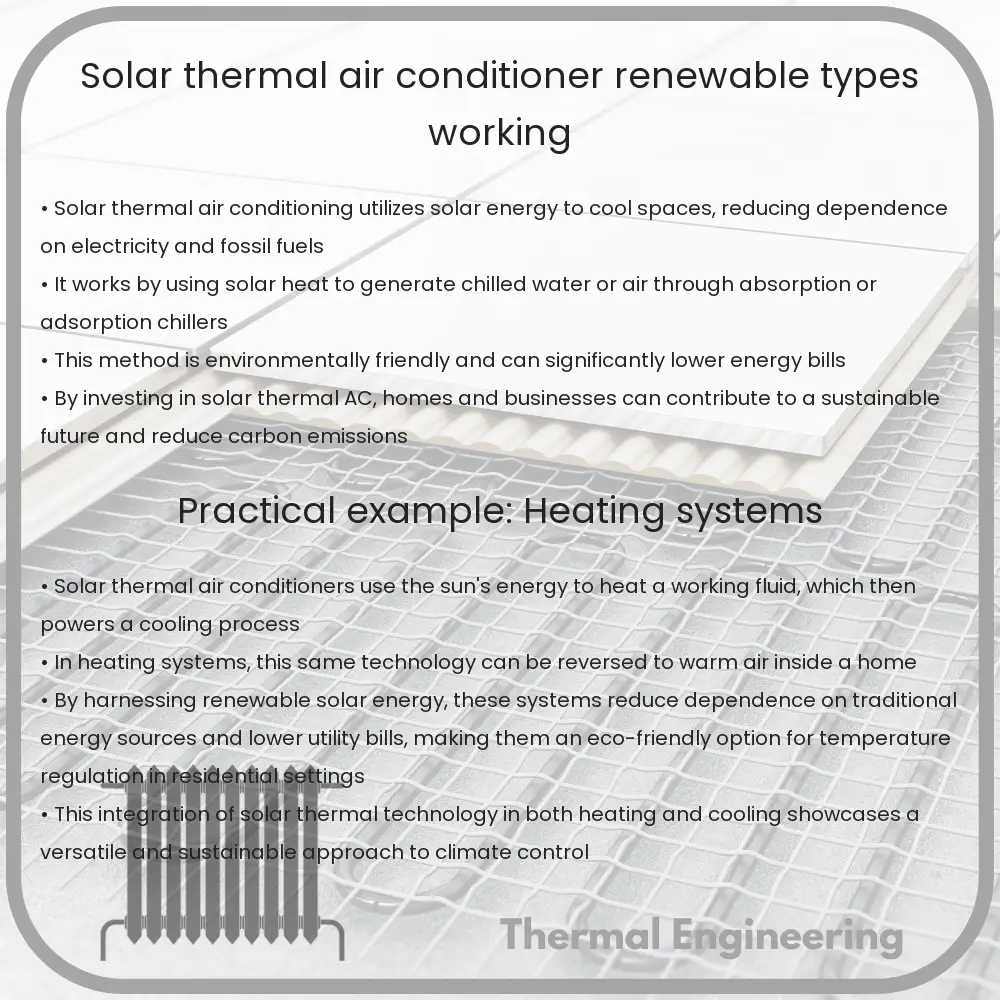Learn how solar thermal air conditioning offers a sustainable cooling solution by utilizing solar energy to reduce electricity use and decrease reliance on fossil fuels.

Introduction to Solar Thermal Air Conditioning
Solar thermal air conditioning harnesses the power of the sun to provide a more sustainable alternative to traditional air conditioning systems. Using solar energy, which is abundant and renewable, this technology offers a means to reduce the reliance on fossil fuels and decrease utility bills. In this article, we will explore the various types of solar thermal air conditioners and how they operate.
Types of Solar Thermal Air Conditioning Systems
- Absorption Chillers: These systems use a thermal-driven chemical process to cool the environment, typically involving a refrigerant paired with an absorbent material.
- Desiccant Cooling Systems: These systems use moisture-absorbing materials to reduce humidity and indirectly cool the air through evaporation.
- Solar-Mechanical Systems: This type employs photovoltaic panels to generate electricity, which then powers a conventional air conditioner or a heat-driven process.
How Solar Thermal Air Conditioners Work
Solar thermal air conditioning systems primarily rely on solar thermal collectors that capture and convert solar energy into heat. This heat is then used in one of several processes to produce cooling effects. Below, we will detail the operational principles of two main types: absorption chillers and desiccant systems.
Absorption Chiller Systems
Absorption chillers utilize heat energy to drive a cooling cycle that involves a refrigerant and an absorbent. The most common pair used is water as the refrigerant and lithium bromide as the absorbent. The process follows several steps:
- The solar collectors gather solar radiation, converting it into heat and transferring it to a heat exchanger.
- This heat is used to boil the refrigerant (water), separating it from the absorbent (lithium bromide).
- The vaporized refrigerant then moves to the condenser, where it is cooled and condensed into a liquid, releasing its heat to the outside.
- The cooled refrigerant flows over the evaporator, where it absorbs heat from the indoor air, thus cooling it.
- This process repeats as the refrigerant returns to combine with the absorbent, ready to be boiled again.
Desiccant Cooling Systems
Desiccant cooling systems use a moisture-absorbing material to remove humidity from the air, which is crucial for hot and humid climates. Here’s how such a system typically operates:
- Solar heat is applied to regenerate the desiccant, driving off the absorbed water vapor and reactivating the desiccant’s drying potential.
- Dry, regenerated desiccant is then exposed to the incoming air stream, where it absorbs moisture from the air, thereby cooling it through evaporation.
- This process not only cools but also dehumidifies the air, making it more comfortable while using significantly less electricity than conventional cooling methods.
Benefits of Solar Thermal Air Conditioning
Solar thermal air conditioning systems offer several advantages, including:
- Reduced Electricity Use: By using solar energy, these systems significantly decrease the demand for electricity.
- Environmentally Friendly: They contribute to reduced carbon emissions and lower dependency on fossil fuels.
- Economic Savings: Reduced energy bills and potential governmental incentives for using renewable energy systems.
Conclusion
Solar thermal air conditioning is a promising technology that utilizes renewable solar energy to provide cooling solutions. Whether through absorption chillers or desiccant systems, these technologies offer an effective way to harness the abundant solar resource, contributing to environmental sustainability and economic benefits. As solar technology advances, solar thermal air conditioning could become a staple in energy-efficient building design.